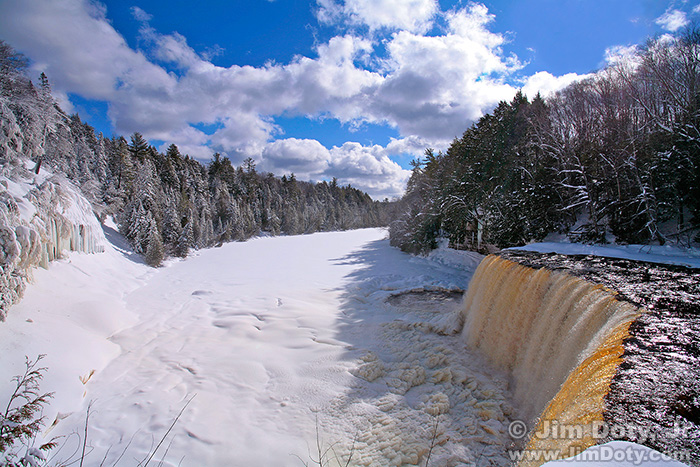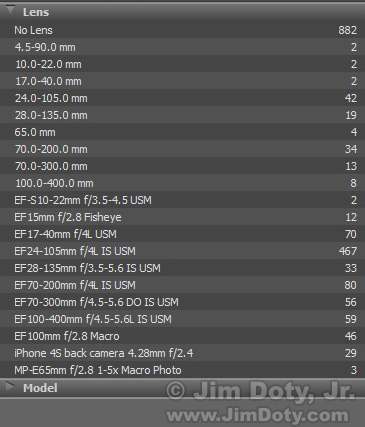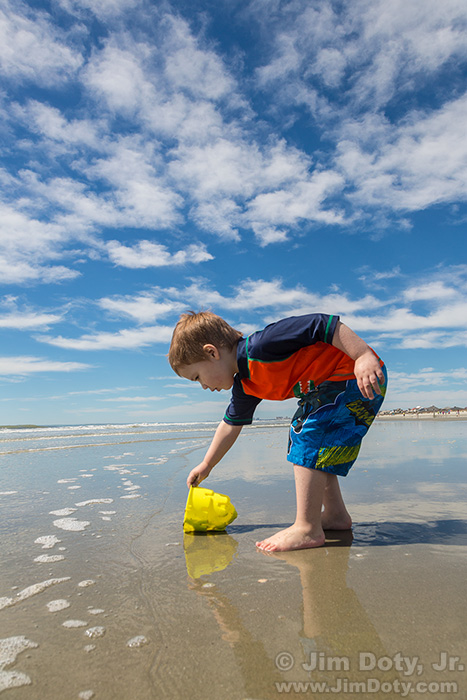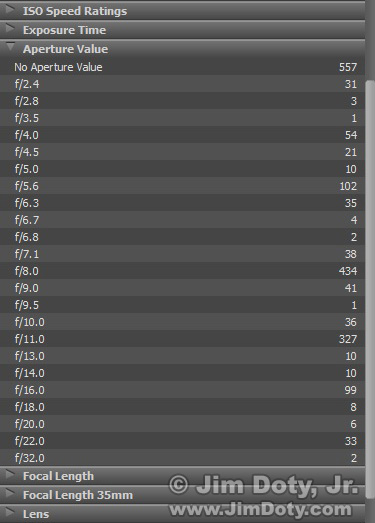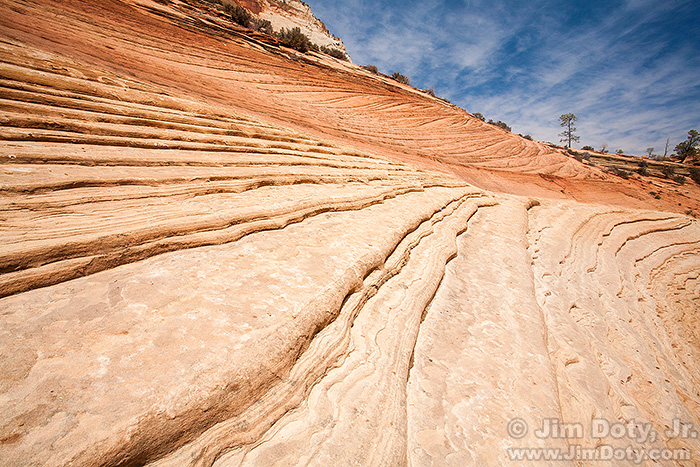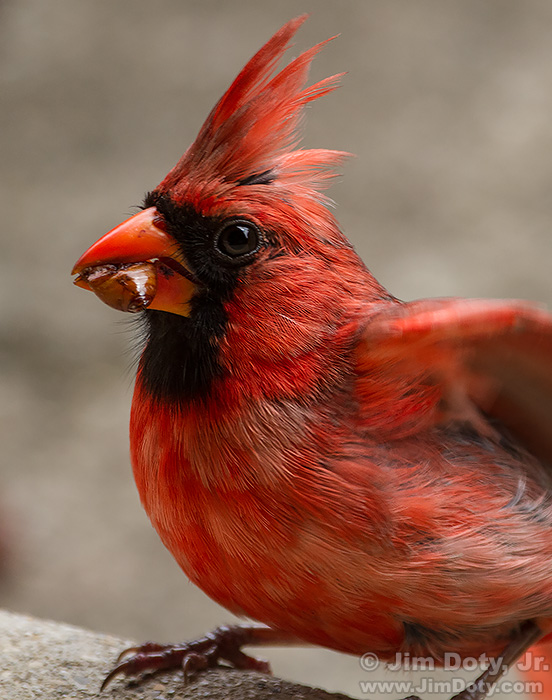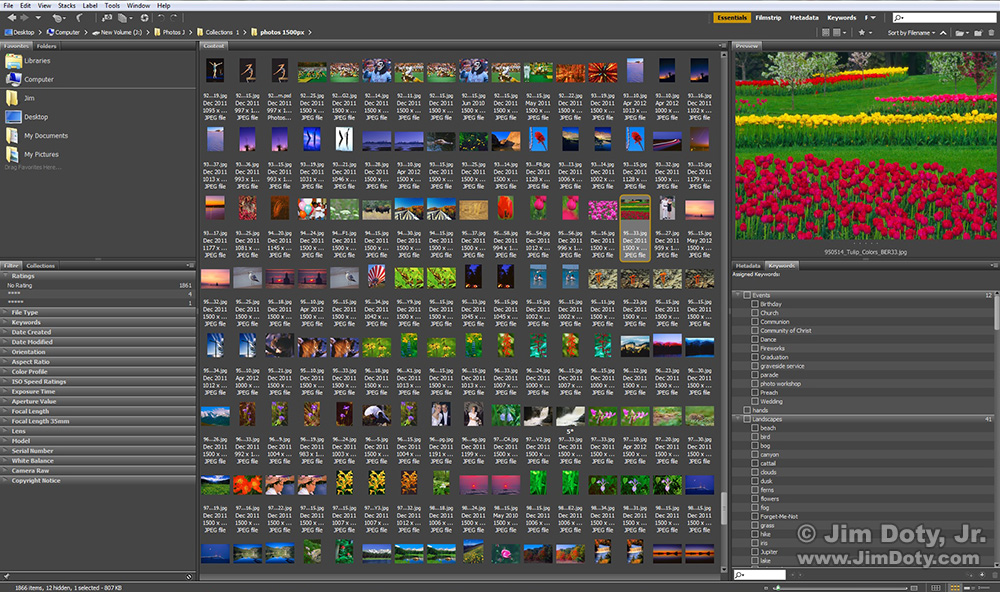
Folder opened with Adobe Bridge. You are looking at 128 images out of over 1800 images in the folder. Click to see a larger version.
I was asked recently if I have a favorite focal length, lens, or aperture setting. And I have also been asked if I have favorite shutter speeds and ISO Settings (see Preferences Part Two). So I decided to open a folder with over 1800 of my images (a little of everything) and take a statistical look at what I do.
(This article was originally written Nov. 11, 2015 and revised Nov. 13, 2015.)
I picked a folder on my hard drive that has the widest variety and highest number of images in a single folder. It has nature photography, landscapes, portraits, sports, event photography, and illustrations for my classes and workshops. I chose Adobe Bridge to view the folder because it shows a breakdown of image attributes in the panels at the lower left. If there is information in the metadata of an image, it shows up in these panels. Not all the images in the folder have this kind of metadata. My older digital cameras didn’t record anywhere near the same amount of information that is stored by current model cameras, and some didn’t store any. My scanned slides don’t have metadata for apertures, shutter speeds, ISO settings, and other information we take for granted in today’s digital files. Despite those limitations, the folder I chose had the broadest range of photographs, covering over 30 years of photography.
FOCAL LENGTHS
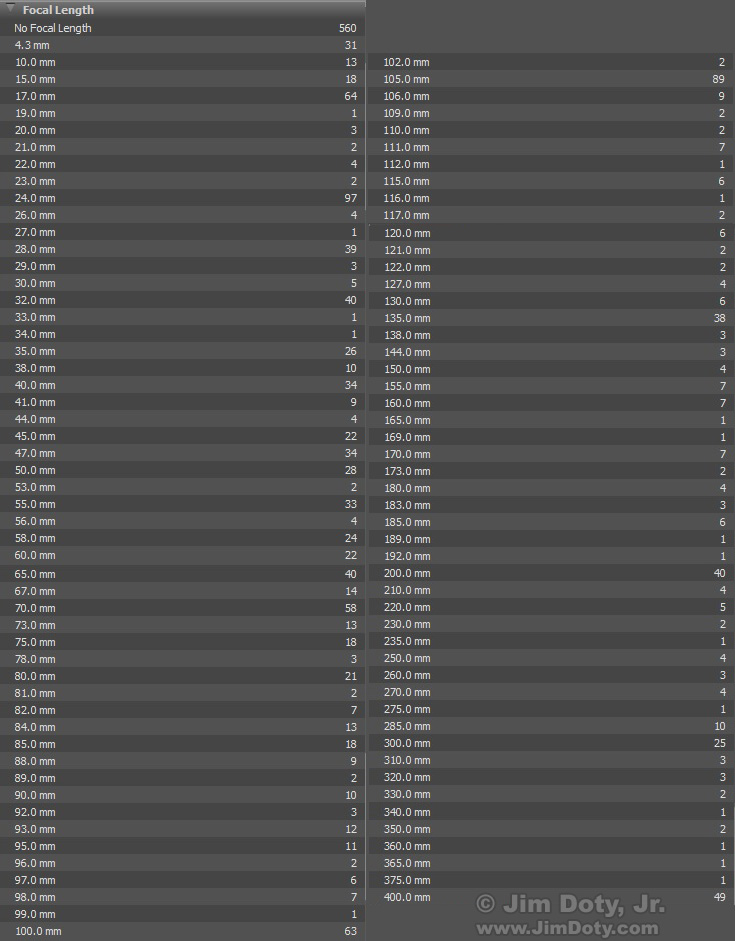
Focal length panel in Adobe Bridge with the number of photos taken at each focal length. Click to see a larger version.
One of the earliest decisions I make when creating an image (after deciding on the subject, the perspective, and the size relationships of the different image elements) is how to frame the image. That is a focal length decision. As you can see from the focal lengths panel from Adobe Bridge, my focal lengths are all over the place from 10mm to 400mm. The 4.3mm images are from my iPhone.
Wide angle focal lengths do tend to cluster around the widest end of my wide angle zoom lenses (10mm, 17mm, and 24mm, see the next section) and telephoto focal lengths tend to cluster around the long end of my telephoto zoom lenses (200mm, 300mm, and 400mm). My theory is this, if the longest lens I have with me at the time is 70-200, I am taking photos at the 200mm end because I wish I had a longer lens with me. The same would be true for my 70-300mm and 100-400mm lenses. You can always use a longer lens. At the other end of the spectrum, there are clearly times that at the widest end of whatever wide angle zoom lens I have with me, I am wanting something wider still.
If I group all of these focal lengths into some arbitrary categories, I get the following:
10-23mm (super wide angle)Â Â Â Â 107 photos
24-35mm (wide angle)Â Â Â Â Â Â Â Â Â Â Â Â Â Â Â 217
36-70mm (mid-range)Â Â Â Â Â Â Â Â Â Â Â Â Â Â Â Â 338
71-105mm (short telephoto)Â Â Â Â Â Â Â 312
106-200mm (telephoto)Â Â Â Â Â Â Â Â Â Â Â Â Â Â 196
210-400mm (long telephoto)Â Â Â Â Â Â Â 140
And if I group them further:
10-35mm (wide)Â Â Â Â Â Â Â Â Â Â Â 324 photos
36-70mm (mid-range)Â Â 338
71-400mm (telephoto)Â Â 648
My wide angle and mid-range focal length photos are about even in numbers, but I do twice as much long lens photography. That makes sense. I use telephoto lenses for wildlife, sports and event photography. I also do a lot of long lens work when I shoot landscapes.
LENSES
Here’s the lens panel in bridge. Metadata gets recorded and processed in different ways so most lenses are on the above list twice (in two different formats:Â “24.0-105.0 mm” vs “EF24-105mm f/4L IS USM”) so you have to add both numbers to get the total number of photos for a particular lens.
I do have a favorite lens, or at least a lens I use more often than the others. Out of 983 photos that have the lens information in the metadata, 509 were taken with the Canon EF 24-105mm lens. That is a little over 50% of the photos. That makes sense. It is the all purpose lens that is on my camera when I head out to take pictures. If I need something wider I switch to a 17-40mm lens. If I need something longer I go to one of my telephoto lens.
Here are the numbers for all of the lenses.
iPhone               31 photos    3% of the photos
15mm fisheye   12                1%
10-22mm           4                  less than 1%
17-40mm          72                 7%
24-105mm       509              52%
28-135mm         52                5%
70-200mm       114               12%
70-300mm         69                 7%
100-400mm       67                 7%
100mm macro   46                 5%
65mm 1x-5x        7          less than 1%
APERTURES
Choosing the aperture is almost always the first exposure decision I make. (Shutter speeds and ISO settings usually come in second.) My aperture choice is usually based on depth of field decisions. If I want to minimize depth of field I choose wide apertures like f/4 or f/5.6.
If I want to maximize depth of field I choose small apertures like f/16 of f/22. If I decide depth of field doesn’t matter (which is still a depth of field decision), I use f/8 (for wide angle and normal focal length lenses) or f/11(for long focal length lenses) because those are usually the sharpest apertures on a lens. Every lens has some apertures that are sharper than other apertures, so when depth of field doesn’t matter, you should pick a sharp aperture. You can see that reflected in my aperture choices above.
761 photos taken at f/8 and f/11. Without even looking at the photos, I know in advance that those apertures were used in situations where depth of field didn’t matter. 148 photos were taken at apertures of f/16 or smaller. Those were high depth of field situations. 191 photos were taken at apertures from f/2.8 to f5/6. Those were situations where I was minimizing depth of field (or wanted a faster shutter speed without raising the ISO).
31 photos were taken a f/2.4. They were all iPhone photos so I had no aperture choice.
SO WHAT DOES THIS ALL MEAN?
Years ago I went through a book by John Shaw and wrote down the lenses, focal lengths, and other photo information for every photo in the book. I put it all in a chart. I thought it might help me. I was impressed with his work and I wanted to take photos like John Shaw. What it really did was show me what worked for John Shaw. I did the same thing with photo information in nature photography magazines. The whole exercise taught me I couldn’t do everything I wanted to do with just one lens. In the end I had to decide what it was that I wanted to do and what would work with me – and then make some lens choices.
The bottom line is focal lengths, lenses, and aperture settings are based on the situation at hand, not on using a favorite lens, aperture, or focal length. It is a photographer’s individual style that determines which choices show up more often than others. Your choices and individual style should be based on what you like to do and what you are trying to accomplish. While it is interesting and somewhat useful to know what other photographers do, it is important that you find your own photographic voice.
Now get out there with your camera and have fun!
Link

